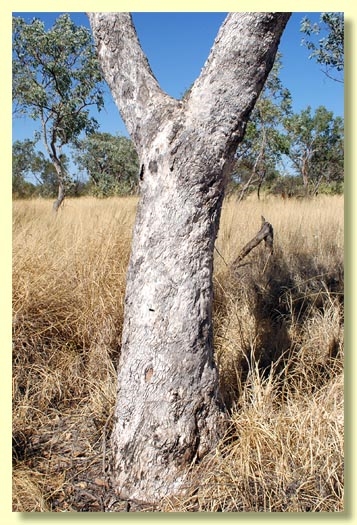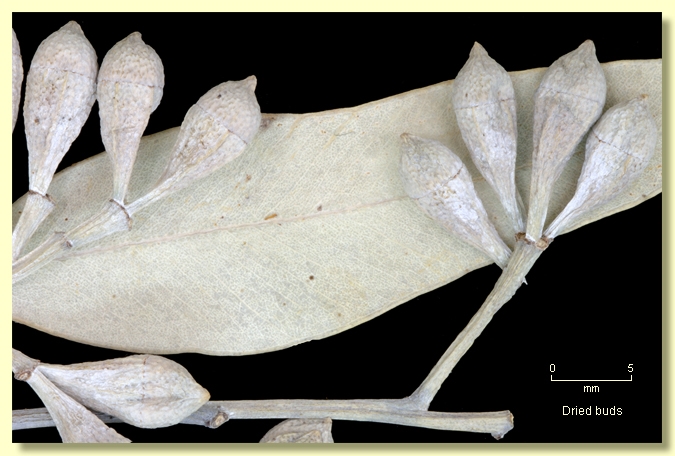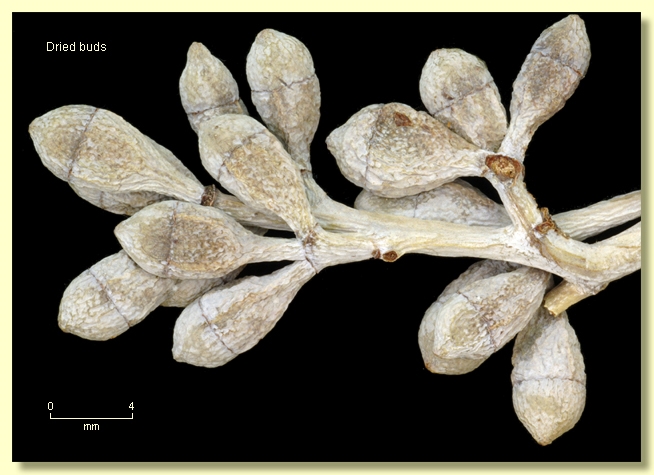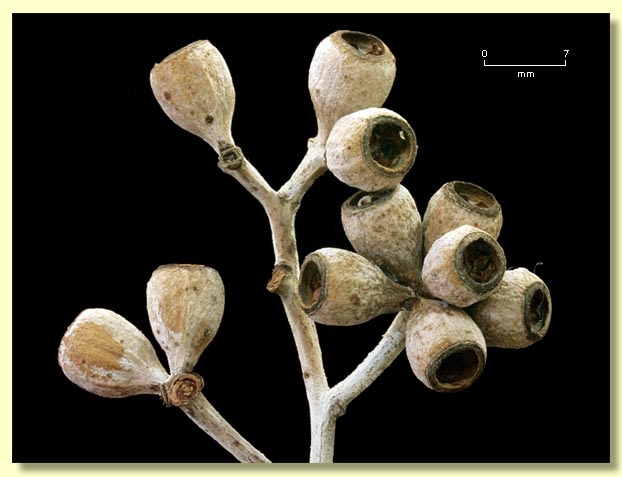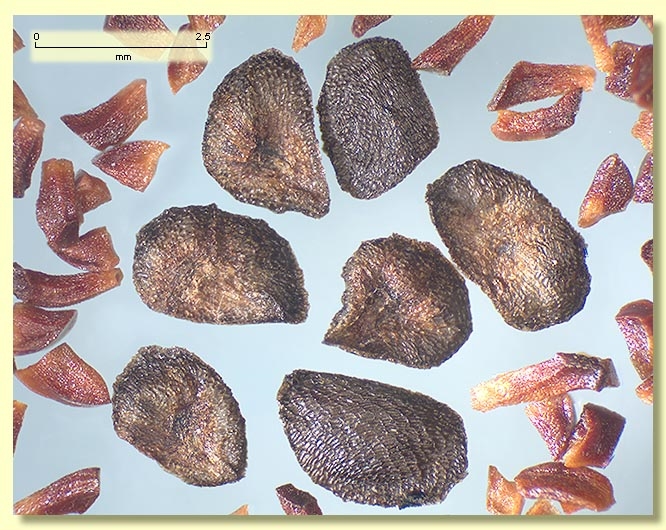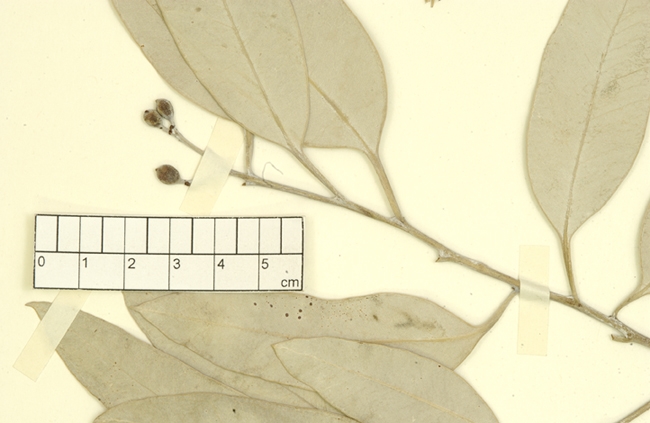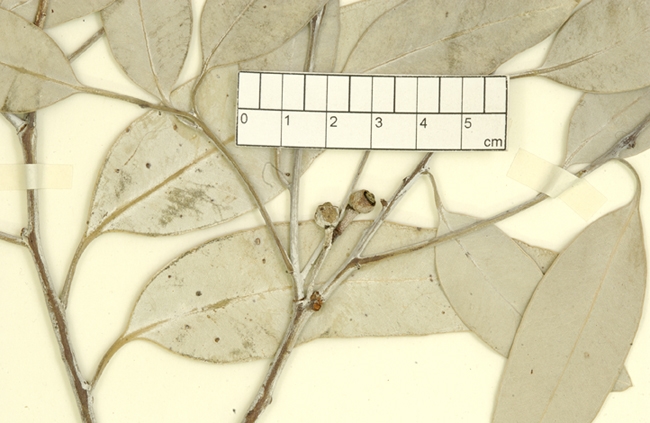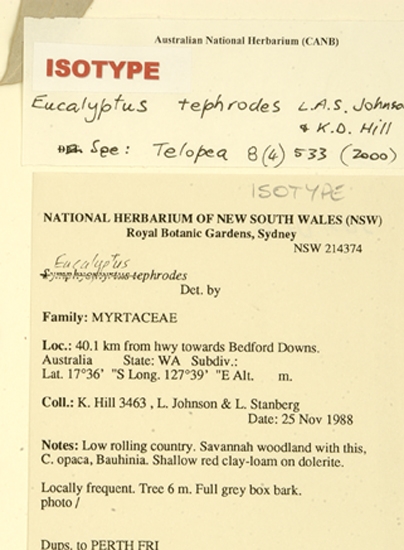Eucalyptus | Symphyomyrtus | Adnataria | Apicales | Aquilonares | Fortes
Euclid - Online edition
Eucalyptus tephrodes
Tree to 12 m tall or sometimes a mallee. Forming a lignotuber.
Bark rough to small branches, grey to whitish grey, box-type.
Branchlets lack oil glands in the pith; glaucous.
Juvenile growth (coppice or field seedlings to 50 cm): stems glaucous, smooth; juvenile leaves always petiolate, alternate, orbicular to ovate, to 7-9.5 cm long, to 4.5-7 cm wide, base more or less rounded, apex rounded or broadly acute, glaucous.
Adult leaves alternate, petioles 1–2.8 cm long; blade ovate to lanceolate or falcate, 7–19 cm long, 1–4.7 cm wide, base tapering, margin entire, apex pointed or rounded, concolorous, dull, blue with at least a slight waxy bloom or quite glaucous, side-veins at greater than 45° to midrib, reticulation very dense, intramarginal vein present, oil glands not visible or few and intersectional.
Inflorescence terminal compound, peduncles rounded to angular, 0.3–1.7 cm long, buds (3)7 per umbel, may sometimes appear irregular due to internode elongation within the umbel, pedicels 0.2–0.5 cm long. Mature buds fusiform to ovoid or obovoid, 0.8–1 cm long, 0.4–0.5 cm wide, glaucous, scar present (outer operculum shed early), operculum beaked or less commonly rounded, stamens irregularly flexed, all fertile, anthers ± adnate (filament tip tapers abruptly), basifixed, cuboid, dehiscing by lateral slits, style straight and long, stigma blunt, locules 4(5), the placentae each with 4 vertical ovule rows. Flowers not seen.
Fruit on pedicels 0.2–0.7 cm long, cupular to hemispherical, about as long as wide, 0.5–0.9 cm long, 0.5–0.8 cm wide, glaucous, disc narrow, descending vertically or almost so, valves 4(5), near rim level.
Seeds dark brown, 1.5–3 mm long, flattened-ovoid, dorsal surface shallowly reticulate, hilum ventral.
Cultivated seedlings (measured at ca node 10): cotyledons small, reniform; stems square in cross-section, slightly glaucous; leaves always petiolate (petioles 0.6–1.1 cm), opposite for 5 to 8 nodes then alternate, broadly lanceolate or ovate, 7.7–11.5 cm long, 1.8–4 cm wide, base tapering to petiole, apex pointed, grey-green to slightly glaucous, sometimes only glaucous on petiole.
Flowering has been recorded in November and December (fide Brooker & Kleinig, 1994).
A small tree or mallee occurring in the Kimberley and Pilbara regions of Western Australia, with restricted distribution in the Bedford Downs to Halls Creek area, and near Mt Meharry and Nullagine. It occurs on a variety of soils, from clay-loams of seasonally dry creek banks to stony soils on slight rises. Eucalyptus tephrodes is distinguished by the full rough box bark, crown of broadly lanceolate glaucous leaves and glaucous branchlets, buds and fruit.
Eucalyptus tephrodes was described subsequent to the classification of the eucalypts published by Brooker (2000). Within that classification E. tephrodes would be placed in Eucalyptus subgenus Symphyomyrtus section Adnataria (the boxes and ironbarks) because the buds have two opercula, ovules are in four rows, seeds are flattened-ovoid, cotyledons are reniform, anthers are rigid on the staminal filaments and bark is shortly fibrous. Within section Adnataria, E. tephrodes would best belong in a subgroup of box species with tropical distribution, series Aquilonares subseries Fortes, having inflorescences terminal on the branchlets, adult leaves with very densely reticulate venation and fruit that are not fragile and have valves more or less at rim level when the fruit is dehisced.
Within its geographic range in the southern Kimberley region the glaucous to bluish crown weakly distinguishes E. tephrodes from E. limitaris, which has a mid-green crown. E. argillacea from the central Kimberley region is glaucous like E. tephrodes but is distinguished by having fragile (thin-walled) fruit that are longer than wide and smaller leaves. E. argillacea prefers plains with clay-loam soil. Further south the Pilbara box species E. xerothermica has stout fruit that tend to be iso-diametric and has green leaves.
In the Kimberley region there are several other fully box-barked species that can readily be distinguished from E. tephrodes, viz. E. tectifica (a widespread species on a variety of soils, with pendulous branchlets, narrow dull green to blue-green lanceolate leaves and fragile cupular to obconical pedicellate fruit that are < 0.8 cm wide); E. obconica (a stunted tree of stony uplands with very narrow dull green to grey-green crown leaves and sessile obconical fruit <0.6 cm wide); E. microtheca (a common tree of river floodplains with green to grey-green or rarely slightly glaucous crown leaves and fragile truncate-globose to obconical shortly pedicellate fruit < 0.7 cm wide); E. chlorophylla (a small tree of plains with glossy green lanceolate leaves and with non-fragile pedicellate fruit longer than wide and < 0.7 cm wide); E. oligantha (a sporadically occurring floodplain species on heavy soils, with a large predominantly deltoid to orbicular green leaves and pedicellate more or less isodiametric fruit 0.6–0.9 cm wide); E. pruinosa subsp. pruinosa (a small glaucous-crowned tree with opposite sessile cordate leaves and more or less cylindrical fruit to 1 cm wide).
The characters distinguishing Eucalyptus tephrodes from the Pilbara endemic box species, E. xerothermica, are weak: overlapping measurements of leaves and fruit, fruit shape and glaucescence, the latter being variable in expression in many eucalypt species. It may be that these two are part of a single variable species possibly involving other box species as well. These two species and E. limitaris form a group of tropical box eucalypts whose closest relative is the Top End endemic, E. patellaris, which has larger more campanulate fruit. The fruit of Eucalyptus tephrodes, E. xerothermica and E. limitaris are variable in shape but never campanulate.
Eucalyptus tephrodes: Greek tephro-, ash-grey, and ending –odes, resembling, referring to the conspicuous bluish grey crown.


